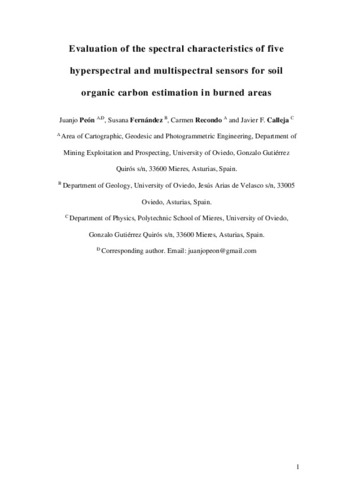Evaluation of the spectral characteristics of five hyperspectral and multispectral sensors for soil organic carbon estimation in burned areas
Fecha de publicación:
Editorial:
CSIRO Publishing
Versión del editor:
Citación:
Descripción física:
Resumen:
Frequent wildfires in the northwest region of Spain affect soil organic matter. Soil properties can be estimated both spatially and temporally using remote sensing. A wide range of satellite and airborne hyperspectral and multispectral sensors are currently available. The spectral resolution varies substantially among sensors, making it difficult to identify the most suitable sensors and spectral regions for a specific application. This study aims to identify the sensors and wavelengths with the greatest potential for topsoil organic C mapping. Total (TOC) and oxidisable organic carbon (OC) content were measured in 89 soil samples collected in a mountain region of northwestern Spain. Reflectance spectra of the samples in the spectral region 400–2450 nm were resampled to the bands of five sensors: Compact Airborne Spectrographic Imager (CASI), Airborne Hyperspectral Scanner (AHS), Hyperion, Landsat 5 Thematic Mapper (TM) and Moderate Resolution Imaging Spectroradiometer (MODIS). Calibration models obtained using partial least-squares regression proved to be effective for hyperspectral sensors and also for the multispectral sensor MODIS (R2 = 0.75–0.89), which suggests that hyperspectral capability is not required to accurately predict topsoil organic C. Models based on Landsat performed well, but with an error around 30–45% greater than that obtained for the hyperspectral sensors and MODIS.
Frequent wildfires in the northwest region of Spain affect soil organic matter. Soil properties can be estimated both spatially and temporally using remote sensing. A wide range of satellite and airborne hyperspectral and multispectral sensors are currently available. The spectral resolution varies substantially among sensors, making it difficult to identify the most suitable sensors and spectral regions for a specific application. This study aims to identify the sensors and wavelengths with the greatest potential for topsoil organic C mapping. Total (TOC) and oxidisable organic carbon (OC) content were measured in 89 soil samples collected in a mountain region of northwestern Spain. Reflectance spectra of the samples in the spectral region 400–2450 nm were resampled to the bands of five sensors: Compact Airborne Spectrographic Imager (CASI), Airborne Hyperspectral Scanner (AHS), Hyperion, Landsat 5 Thematic Mapper (TM) and Moderate Resolution Imaging Spectroradiometer (MODIS). Calibration models obtained using partial least-squares regression proved to be effective for hyperspectral sensors and also for the multispectral sensor MODIS (R2 = 0.75–0.89), which suggests that hyperspectral capability is not required to accurately predict topsoil organic C. Models based on Landsat performed well, but with an error around 30–45% greater than that obtained for the hyperspectral sensors and MODIS.
ISSN:
DOI:
Patrocinado por:
The Government of Asturias [SV-PA-13-ECOEMP-40]; Spanish Ministry of Education [FPU14/01350]; Government of Asturias [BP14-104]; University of Oviedo
Colecciones
- Artículos [37542]
- Explotación y Prospección de Minas [323]
- Indurot [171]
- Investigaciones y Documentos OpenAIRE [8401]
Ficheros en el ítem





